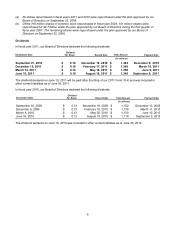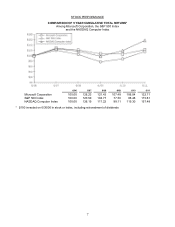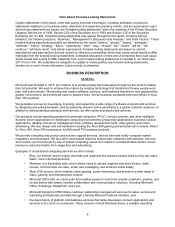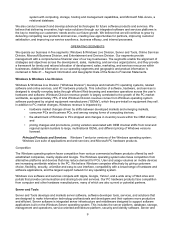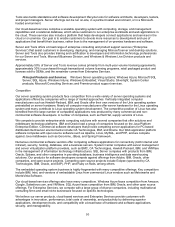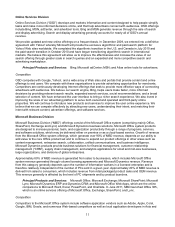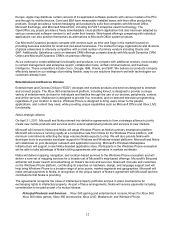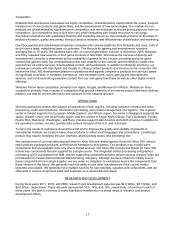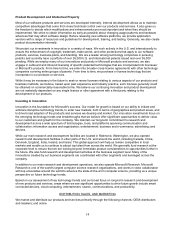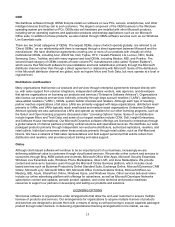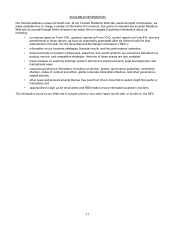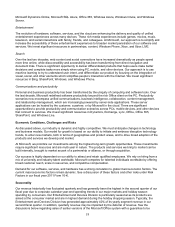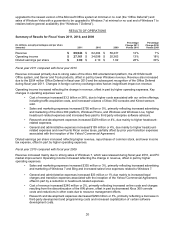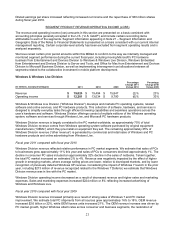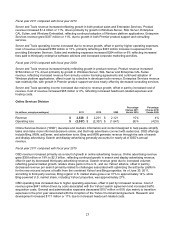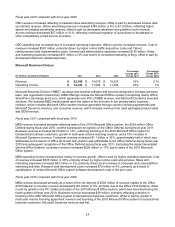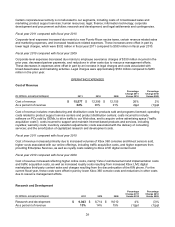Microsoft 2011 Annual Report Download - page 16
Download and view the complete annual report
Please find page 16 of the 2011 Microsoft annual report below. You can navigate through the pages in the report by either clicking on the pages listed below, or by using the keyword search tool below to find specific information within the annual report.
16
different programs designed to provide flexibility for organizations of various sizes. While these programs may
differ in various parts of the world, generally they include those discussed below.
Open Licensing
Designed primarily for small-to-medium organizations (5 to over 250 licenses), Open licensing programs allow
customers to acquire perpetual or subscription licenses and, at the customer’s election, rights to future versions of
software products over a specified time period (two or three years depending on the Open program used). The
offering that conveys rights to future versions of certain software products over the contract period is called
software assurance. Software assurance also provides support, tools, and training to help customers deploy and
use software efficiently. Under the Open program, customers can acquire licenses only, or licenses with software
assurance. They can also renew software assurance upon the expiration of existing volume licensing
agreements.
Select Licensing
Designed primarily for medium-to-large organizations (greater than 250 licenses), the Select program allows
customers to acquire perpetual licenses and, at the customer’s election, software assurance over a specified time
period (generally three years or less). Similar to the Open program, the Select program allows customers to
acquire licenses only, acquire licenses with software assurance, or renew software assurance upon the expiration
of existing volume licensing agreements. Online services are also available for purchase through the Select
program, and subscriptions are generally structured with terms between one and three years.
Services Provider Licensing
The Microsoft Services Provider License Agreement (“SPLA”) is a program targeted to service providers and
Independent Software Vendors (“ISVs”) allowing these partners to provide software services and hosted
applications to their end customers. Agreements are generally structured with a three-year term, and partners are
billed monthly based upon consumption.
Enterprise Agreement Licensing
Enterprise agreements are targeted at medium and large organizations (greater than 250 licenses) that want to
acquire licenses to software products, along with software assurance, for all or substantial parts of their
enterprise. Enterprises can elect to either acquire perpetual licenses or, under the Enterprise Subscription
program, can acquire non-perpetual, subscription agreements for a specified time period (generally three years).
Online services are also available for purchase through the Enterprise agreement and subscriptions are generally
structured with three year terms.
CUSTOMERS
Our customers include individual consumers, small- and medium-sized organizations, enterprises, governmental
institutions, educational institutions, Internet service providers, application developers, and OEMs. Consumers
and small- and medium-sized organizations obtain our products primarily through distributors, resellers, and
OEMs. No sales to an individual customer accounted for more than 10% of fiscal year 2011, 2010, or 2009
revenue. Our practice is to ship our products promptly upon receipt of purchase orders from customers;
consequently, backlog is not significant.
EMPLOYEES
As of June 30, 2011, we employed approximately 90,000 people on a full-time basis, 54,000 in the U.S. and
36,000 internationally. Of the total, 35,000 were in product research and development, 25,000 in sales and
marketing, 16,000 in product support and consulting services, 5,000 in manufacturing and distribution, and 9,000
in general and administration. Our success is highly dependent on our ability to attract and retain qualified
employees. None of our employees are subject to collective bargaining agreements.


